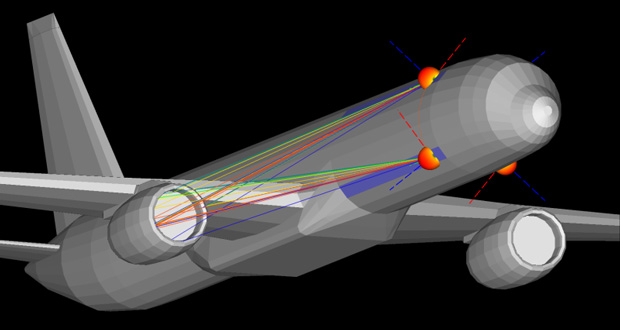Editor’s Pick: XGtd 2.8

Version 2.8 of Remcom’s XGtd high-frequency ray-based electromagnetic simulation software introduces new co-site analysis features. In this example, co-site interference simulation finds the strongest propagation paths between two patch antennas mounted on the exterior of a Boeing 757 jetliner. Image courtesy of Remcom Inc.
July 13, 2016
When I was a kid, my mother always had the AM radio tuned to the chattering of “Rambling with Gambling” on WOR New York. It drove her nuts when our neighbor fired up his Triumph Spitfire because it radiated noise that turned the conversation to a whizzing static mess. In today’s electro-mechanical world, the last thing you want is EMI (electromagnetic interference) messing with sensitive electronics. Today’s Pick of the Week looks at a new version of what’s often the tool of choice for engineers assessing radiation effects.
Remcom recently announced the availability of version 2.8 of its XGtd general-purpose, high-frequency ray-based electromagnetic simulation software. The XGtd application is part of Remcom’s suite of wireless propagation and electromagnetic simulation software for modeling propagation with devices in real world scenarios. The applications all work together and provide what you need to model EMI and electromagnetic compatibility, radar and scattering, microwave circuits and so on.XGtd’s role is to help you evaluate the effects of vehicles or vessels on antenna radiation as well as estimating radar cross section and predicting coupling between antennas. A particular strength is that it works well for jobs with higher frequencies or focused on very large platforms where a full physics approach could overtax your computational resources.
XGtd version 2.8 has several interesting new features. Among these are a new Touchstone file format export functionality as well as new support for importing and creating KMZ (.kmz) and COLLADA (.dae) geometry files, which should speed up importing complex, high-resolution objects for an analysis project. There’s also a new 64-bit GUI (graphical user interface), which should definitely improve overall performance when processing memory-intensive models.
The key new enhancements are several co-site analysis features. These let you do things like calculate paths and coupling between transmitters and receivers for EMI assessments as well as electromagnetic compatibility (EMC) assessments. Remcom explains that the addition of transceivers simplifies co-location of functionally independent transmitters and receivers. You can assign different transmitter and receiver properties to a common transceiver location. This includes antenna gain pattern, antenna rotation and waveform.
 Version 2.8 of Remcom’s XGtd high-frequency ray-based electromagnetic simulation software introduces new co-site analysis features. In this example, co-site interference simulation finds the strongest propagation paths between two patch antennas mounted on the exterior of a Boeing 757 jetliner.
Version 2.8 of Remcom’s XGtd high-frequency ray-based electromagnetic simulation software introduces new co-site analysis features. In this example, co-site interference simulation finds the strongest propagation paths between two patch antennas mounted on the exterior of a Boeing 757 jetliner. Image courtesy of Remcom Inc.
You can learn more about XGtd version 2.8 starting with today’s Pick of the Week write-up. Make sure to take in the very brief videos. They’re registration free, and only one runs as long as six minutes. Hit today’s Pick of the Week link to get started. Well worth it.
Thanks, Pal. – Lockwood
Anthony J. Lockwood
Editor at Large, DE
Subscribe to our FREE magazine, FREE email newsletters or both!
About the Author
Anthony J. Lockwood is Digital Engineering’s founding editor. He is now retired. Contact him via [email protected].
Follow DE






